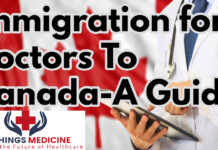Page Contents
The USA is without doubt, one of the best countries to study and practice medicine in. The better quality of life, facilities, advanced technology, and a good healthcare system entice international medical graduates. Every year, a number of international medical graduates (IMGs) apply for a visa in order to enter a US-based residency program. In this article, I will provide insight on the types of visa required for IMGs in the US and the entire process involved in obtaining it. It is a lengthy and financially draining process to obtain a residency position in the US but once you get through, it is all worth it.
Why practice medicine in the US?

The US is one of the top destinations when it comes to practicing medicine. The US has a great healthcare system with advanced technology and facilities. The residency program comes with a steep learning curve and a lot of exposure.
Doctors in the US are also highly paid and are respected. In addition, there are a lot of job opportunities and job security. Residency in the US is also an important step towards obtaining immigration.
You would not even have to worry about the tuition fee as the hospital will pay you for the residency. Post graduation degree earned from the US is also recognized all over the world. In addition, it involves experiencing working in a different healthcare system than your home country.
Who is an International Medical Graduate?
An international medical graduate is a student who has obtained her/his medical degree from a medical school located elsewhere in the world and not in the US or Canada, which is not accredited by The Liaison Committee on Medical Education (LCME). Medical students who are not US citizens but have studied and graduated from medical schools in the US and Canada are not IMGs. On the other hand, US citizens, who have studied and graduated from medical schools located outside of the US and Canada are considered IMGs.
Types of visa for IMGs in US

International medical students require a visa in order to be able to enter a US-based residency program. US citizens and Green Card holders do not require a visa. There are two most common visa options:
- H-1B visa (Temporary Worker)
- J-1 visa (Exchange Visitor)
You do not need to apply for a visa until you have matched in a residency program. Sometimes, the institute sponsors the visa. In addition, the ECFMG can also sponsor the J-1 visa for IMGs.
J-1 visa
J-1 visa is the most common visa for IMGs. Only ECFMG is authorized to sponsor it for IMGs. However, some other institutions may also sponsor it for the research department. The requirements for obtaining J-1 visa are:
- USMLE step 1 and step 2 CK must be cleared
- Valid ECFMG certification
- Offer letter from a residency program in the US
- A statement of need (SON) issued by the Health Ministry of the home country or last legal permanent residence.
The J-1 visa is for physicians opting for a training program only. With this visa, you can only work as a trainee and not as an attending or have a secondary job (medical or non-medical).
In addition, another requirement (home residency requirement) of the J-1 visa states that you have to go back to your home country for two years after completing your training before you can apply for any other US visa status. This requirement proves to be troublesome for some physicians who land a great career opportunity later and are not able to opt for it because they are obligated to leave the country for 2 years as per the home residency requirement.
However, you can escape this situation by obtaining a waiver. Although it is tough and has certain requirements, you can still try.
Learn more about obtaining a waiver for home residency requirements here
H-1B visa
H-1B visa is preferable because it does not have a home residency requirement. Physicians are not required to go back to their home country for 2 years after completing their residency program. With this visa, physicians are also able to do moonlighting.
It is meant for professional-level degree holders and is sponsored by the institution offering a position to the physician. It does however take a long time due to the requirements and work involved in obtaining it. The requirements for obtaining H-1B visa are:
- All three steps of USMLE must be cleared including Step 3.
- Valid ECFMG certificate
- Medical license to practice in the US
You can also apply for permanent residency status while you have a H-1B visa.
Other types of visa for IMGs
O-1 visa: It is a non-immigrant visa granted to individuals with great abilities in the field of science. It can be applied for by physicians for clinical track although it is more commonly used for research positions.
TN visa: TN visa is meant for Canadian and Mexican residents/physicians who are interested in teaching or researching in the field of medicine. It is not intended for physicians seeking to practice medicine in the US.
Immigrant visa: Obtaining an immigrant visa (Green Card) is a great way to enter and remain in the US without having to get a visa.
Frequently asked questions about type of visa for IMGs in US
Conclusion
The road to practicing medicine in the US is complicated and lengthy. However, due to numerous job opportunities, handsome salary, and better living standards, the US is one of the best places to practice in.
To sum it up, international medical graduates who wish to apply for residency in the US need to have the required qualifications and degree, a valid ECFMG certificate, clear USMLE, apply for a residency program, obtain medical license, and obtain a visa. To make it easier for you, in this guide, I have enlisted the types of visa for IMGs in the US and the criteria to obtain them.
Recommended articles














